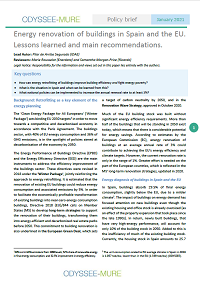Summary
Key questions
- How can energy retrofitting of buildings improve building efficiency and fight energy poverty?
- What is the situation in Spain and what can be learned from this?
- What national policies can be implemented to increase the annual renewal rate to at least 3%?
Lead authors: Pilar de Arriba Segurado (IDAE, Spain)
Reviewers: Marie Rousselot (Enerdata) and Samantha Morgan-Price (Ricardo)
Background: Retrofitting as a key element of the energy planning
The 'Clean Energy Package for All Europeans' ('Winter Package') sets binding EU 2030 targets1 in order to move towards a competitive and decarbonised economy in accordance with the Paris Agreement. The buildings sector, with 40% of EU energy consumption and 36% of GHG emissions, is in the spotlight of policies aimed at decarbonisation of the economy by 2050.
The Energy Performance of Buildings Directive (EPBD) and the Energy Efficiency Directive (EED) are the main instruments to address the efficiency improvement of the buildings sector. These directives were revised in 2018 under the 'Winter Package', jointly reinforcing the approach to energy retrofitting. It is estimated that the renovation of existing EU buildings could reduce energy consumption and associated emissions by 5%. In order to facilitate the economically profitable transformation of existing buildings into near-zero energy consumption buildings, Directive 2018 (EU)/844 calls on Member States (MS) to develop long-term strategies to support the renovation of their buildings, transforming them into energy-efficient and decarbonized real estate parks before 2050. This commitment to building renovation is also underlined in the European Green Deal, which sets a target of carbon neutrality by 2050, and in the Renovation Wave Strategy, approved in October 2020.
Much of the EU building stock was built without significant energy efficiency requirements. More than half of the buildings that will be standing in 2050 exist today, which means that there is considerable potential for energy savings. According to estimates by the European Commission (EC), energy renovation of buildings at an average annual rate of 3% could contribute to achieving the EU's energy efficiency and climate targets. However, the current renovation rate is only in the range of 1%. Greater effort is needed on the part of the European countries, which is reflected in the MS' long-term renovation strategies, updated in 2020.
Energy diagnosis of buildings in Spain and the EU
In Spain, buildings absorb 29.5% of final energy consumption, slightly below the EU, due to a milder climate2. The impact of buildings on energy demand has focused attention on new buildings even though the existing housing and office stock is already oversized (as an effect of the property expansion that took place since the late 1990s). In return, newly built buildings, that have very high-energy performance, will account for only 10% of the building stock in 2050. Added to this is the inefficiency of much of the existing building stock. Currently, the housing stock in Spain amounts to 25.7 million (Ministry of Transport, Mobility and Urban Agenda (MITMA)). 74.6% correspond to primary residences, mostly of a multifamily type (68%). The housing stock for non-residential use is close to 2 million properties according to the Statistics of the Real Estate Cadastre. More than half of the houses and properties were built prior to the first regulation approved in Spain, NBE-CT 79, which required a minimum level of thermal insulation in building envelopes (Figure 1). The subsequent adoption of the Technical Building Code (TBC) in 2006 was a step forward with respect to previous regulations.
Figure 1: Building stock by uses and construction periods in Spain
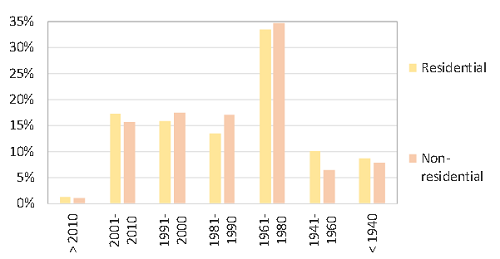
Source: MITMA/MINHAP/INE/IDAE
There is a significant volume of properties that lack insulation and are susceptible to an energy retrofitting, with a great potential for savings. Potential savings increase if renovation of thermal installations also is considered: 88% of the primary residences have heating systems where 42.1% of household consumption is concentrated (Figure 2).
Figure 2: Energy consumption by end uses in the household sector in Spain and the EU
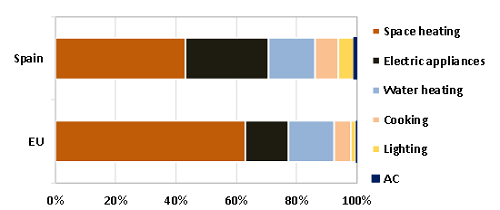
Source: ODYSSEE/IDAE
For these reasons, there is a strong interest in promoting actions to improve the efficiency related to heating, whether by interventions on the heating systems or on the buildings envelopes.
Situation of retrofitting in Spain and the EU
The activity associated with retrofitting in Spain has a favourable evolution according to the construction management visa statistics for reform and/or restoration, with a 10.1% increase between 2017 and 2019 in the number of visas for the rehabilitation of buildings and a 35.6% increase in the budget for implementing the corresponding reforms. This corresponds to a total of 31,110 building renovation visas and a budget of €4,213 M in 2019 (MITMA). This growth is more visible in residential buildings, where retrofitting, in terms of turnover, exceeds new construction since 2015.
Despite this advance, the rate of retrofitting in Spain is still slower than the EC’s suggested rate of 3%, required to effectively contribute to energy and climate targets. According to EC data, the percentage of residential buildings undergoing deep renovation in Spain was barely 1% in 2014, compared to 1.7% in France or 1.5% in Germany. In general, in-depth reforms have limited weight in the EU according to an EC study on buildings renovation3.
In view of the depth4 of the refurbishments, the light ones (savings below 30%) are predominate in Spain and have a higher share than in other EU countries. Deep renovations5, in turn, only affect 0.2-0.3% of the floor area of residential and non-residential buildings in the EU (Figure 3). Based on this study, the speed at which the EU building stock improves its energy performance represents an annual reduction of the primary energy consumption of the housing stock, which leads to a weighted energy renewal rate of 1%. A further boost is therefore necessary, especially in terms of deep renovations.
Figure 3: Energy renovation in residential and no-residential buildings (average 2012-2016) by renovation depths4 in the EU
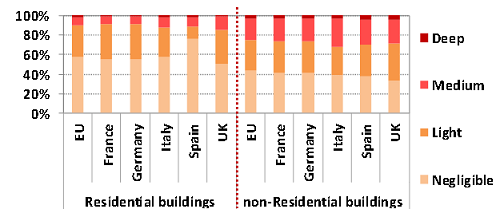
Source: EC. DG Energy. Note: Results based on floor.
Mechanisms in Spain and the EU
At EU level, there are a large and diverse number of measures aimed at renovating buildings. These measures are mainly part of MS' long-term strategies for renovation, which are the main instrument for moving towards the goal of decarbonisation and efficiency improvement of buildings. The typology of measures, present in the EU countries, can be summarised in the following categories: regulatory, financial, fiscal, training, labelling and voluntary agreements (Figure 4), with the first three playing a major role, according to an EC assessment6. These results are also in line with the information available in the MURE Database for the building sector. The number of each type of measures varies among countries, from Malta and Estonia with just one type to Finland, France, The Netherlands and Slovenia with all the identified types. The financial measures are available in all the EU countries.
In the field of energy retrofitting of buildings, Spain has a similar typology of measures to that of other EU countries, with two prevailing types. The regulatory measures include Law 8/2013, of 26 June, on Urban Rehabilitation, Regeneration and Renewal; Royal Decree 235/2013, of 5 April, approving the energy certification of buildings; Royal Decree 238/2013, of 5 April, concerning the Regulations on Thermal Installations of Buildings (RITE); and Royal Decree 732/2019, of 20 December, amending the Technical Building Code. On top of this, there are new legislative developments in progress regarding self-consumption, energy communities and energy poverty.
Figure 4: Types of measures in the building sector in the EU

Source: EC Joint Research Centre (JRC)/MITMA/IDAE. Note: The figures in brackets indicate the number of types of measures.
As regards financial measures, there are currently a number of support programmes for retrofitting, which generally make aid conditional on achieving efficiency requirements. A selection of outstanding programmes at the state level is shown in the Table 1. The PAREER-CRECE Programme is noteworthy for its success. This programme, with a budget of € 200 M, was launched at the end of 2013 by the Ministry for the Ecological Transition and the Demographic Challenge (MITERD) through IDAE, with the aim of promoting comprehensive actions to encourage the improvement of energy efficiency and the use of renewable energies in the existing building stock.
Table 1: Selection of state financial support measures for energy retrofitting
|
Programme |
Subprogrammes with an impact on energy retrofitting |
Budget |
|
PAREER aid programmes for energy retrofitting of existing buildings (1)(2) |
€404 M |
|
|
MITMA State Housing Plan 2018-2021 (PEV) |
'Programme for the promotion of energy efficiency and sustainability in housing' and 'Programme for the promotion of urban and rural regeneration and renovation' |
A total investment of €442.5 M is expected to be leveraged by supporting these two programmes |
|
ICO Line- Companies and Entrepreneurs |
Specific line of financing for individuals and housing associations exclusively for the rehabilitation of homes and buildings |
1,559 transactions registered in the 2017-2019 period, with a loan volume of €76 M |
|
Multiregional OP for Spain (POPE) ERDF 2014-2020 |
Axis 4 - Low Carbon Economy |
€95 M |
|
Axis 4 - Low Carbon Economy |
€865M/ OE 431 Energy efficiency in building and public infrastructures and services |
|
|
Axis 12: Sustainable and Integrated Urban Development |
€140 M/ OE 4.5.3. Improving energy efficiency and increasing renewable energy in urban areas. |
|
Source: IDAE/MURE
(1) Aid for these programmes could be co-financed with ERDF Funds (under the Operational Programme for Sustainable Growth 2014-2020, now POPE). This aid could be improved with additional support according to three criteria (social, energy efficiency or integrated action).
(2) The PREE program, with a budget of €300 M, was launched in august 2020 and is still on-going.
Among the eligible actions, the following typologies were considered: improvement of the energy efficiency of the thermal envelope; improvement of the energy efficiency of thermal and lighting installations; replacement of conventional energy by geothermal energy/biomass in thermal installations. The supported actions had to improve the total energy rating of the building by at least one letter on the EPC scale7.
The interest raised by this programme led to the depletion of funds in May 2016 with 2,488 applications, exceeding the planned budget by 35%. 1,513 applications have been approved, with a volume of aid of €180 M, leveraging an investment of €303 M. Following this programme, the PAREER II Programme was approved at the end of 2017 with a budget of €204 M. The types of eligible actions are similar to those of the previous programme, with the difference that the substitution of conventional energy is carried out by solar thermal instead of biomass. At the end of March 2020, 966 applications were favourably assessed, out of a total of 1,566, representing aid of €174 M, with an investment of €259 M.
Most of the applications approved in both programmes correspond to actions on the building envelope, mainly in buildings aged 40 to 60 years, as well as to homeowners' communities, in a range of 90% or more. The applications favourably assessed represent an overall improvement in the efficiency of 66,662 dwellings and 9,383 rooms in hotels and residences, with a total fitted out area of over 6.6 million m2. 60.3% of the beneficiary actions have shown an improvement in the energy rating of one letter of the EPC scale, 36.1% two letters and only 4%, three or more letters. Most of the improvement has been obtained in dwellings with initial energy rating between E and G, where the applicants of aids are concentrated (Figure 5). These actions account for energy savings of 49.2 ktoe/year, as well as avoided emissions of 145.3 ktCO2/year.
Figure 5: PAREER II Program: Improvement of the energy rating of the renovated buildings
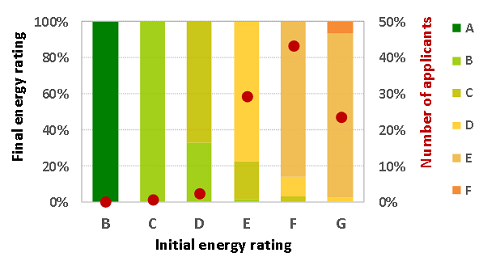
Source: IDAE
The possibility of applying for financing has been the major innovation of these programmes, removing one of the main barriers to rehabilitation. In addition, the low interest loans (Euribor + 0) up to 12 years has been a key point in the success of these programmes. On the other hand, unlike other aid lines, the aid intensity level varies depending on the fulfilment of different criteria (social, energy efficiency; integrated actions). In summary, the funding (in the form of loans and grants) sustainability and continuity based on sufficiently lasting commitment and results achieved (high demand of applicants and improvement of the ratio of the deep renovations) make these programmes attractive, reliable and profitable for all market agents. The results achieved help to understand the potential of these actions in the efficiency improvement of the building stock, so that energy retrofitting is expected to play a relevant role in future energy policies.
Energy retrofitting policies in the 2020-2050 horizon in Spain
The National Integrated Energy and Climate Plan 2021-2030 (NCEP, in Spanish PNIEC) is committed to the energy retrofitting of the existing building stock. The retrofitting objectives are embodied in two measures targeting existing buildings in the residential and tertiary sectors. These measures are consistent with the Long-term Strategy for Building Renovation, as well as with the PEV. In the case of residential buildings, and altogether they have an accumulated final energy savings target of 6,134.7 ktoe over the period 2021-2030, that is 16.7% of the objective set in accordance with the Article 7 of the EED for that period. 77.5% of the savings goes to the residential sector and is expected to be achieved through interventions on the envelope of 1,200,000 dwellings (6.4% of the current stock of dwellings) throughout the period, as well as through the renovation of thermal installations in more than 300,000 dwellings/year. Priority is given to the building envelope, considering that the reduction of thermal demand must be addressed first, in order to avoid over-sizing the thermal installations to meet such demand. In the tertiary sector, the savings objective is expected to be achieved as a result of the annual energy renovation of 5 million m2 of public and private building stock, by means of actions on the envelope and the thermal and lighting installations. Total public support for these measures is estimated at €7,675 M, which will leverage an investment of €26,102 M, mainly in relation to reforms in residential buildings. The measures include several legislative, financial, training and information procedures. In the tertiary sector, legislative measures include extending the mandate of Article 5 of the EED to all public administrations.
The Long-term Strategy for Energy Retrofitting in the Building Sector in Spain (ERESEE 2020) establishes a roadmap for the decarbonisation of housing stock in 2050. The ERESEE 2020 Strategy is consistent with the NCEP and the Long-Term Decarbonisation Strategy (ELP). The objective for 2030 is to reduce final energy consumption in the building sector by 43,464 GWh with respect to current consumption, with 73.7% of this reduction corresponding to thermal uses. 60.7% of the consumption reduction target is concentrated in the residential sector. The baseline scenario of the Strategy in this sector, in line with the NCEP, envisages the renovation of the envelope of 1.2 million dwellings and the replacement of more than 3.5 million heating and water systems by 2030. In the tertiary sector, the reduction target is largely associated with improving the efficiency of public administration buildings. For 2050, the objective is to reduce building consumption by 36.6% with respect to current consumption, bringing fossil consumption to practically zero. The largest contribution to this reduction (67%) comes from the residential sector, where there is a goal of deep energy retrofitting of 7.1 million dwellings by 2050, starting with the most profitable (1.2 millions) in the 2020-2030 period. The planned investment in these interventions is above €100,000 M.
The Strategy integrates a package of structured measures in different axis of action: promoting sectoral coordination; regulatory development in favour of energy retrofitting; retrofitting of public administration buildings; public funding; promotion and mobilization of private funding; fight against energy poverty; deployment of a new energy model in the building and retrofitting sector. These measures aim to address barriers that hinder energy retrofitting, such as the cost of interventions (from €5,000 to €40,000) and the difficulty of financing works through the capitalization of energy savings in Spain in contrast to other EU countries, given the lower household consumption due to a milder climate. To this are added the tariff structure with a high share of fixed costs over the variable costs associated with consumption and the prevailing type of housing (multi-family), which makes it difficult to carry out these reforms since decisions must be collective, subject to rules in accordance with the Horizontal Property Law.
The Strategy seeks to face energy poverty, caused by factors such as constructive housing inefficiency and lack of heating systems. This implies reduced consumption by vulnerable households. Energy retrofitting can be a preventive measure that helps prevent future increases in consumption, once the economic conditions of these households improve.
Main conclusions and recommendations
- According to the IEA8, the retrofitting actions could improve the energy intensity of the overall building stock by 35% by 2050.
- Retrofitting rates need to be increased in order to achieve the expected savings targets. While this is a challenge, retrofitting has positive effects on health, economy and energy poverty. According to the ERESEE 2020 Strategy, it is estimated that the retrofitting target in Spain by 2030 will contribute to creating between 32,000 and 85,000 jobs between 2021 and 2030, as well as accumulated savings of €7,730 M in energy bills. Added to this is a saving of 370 euros per house in health and labour costs for the public administration.
- Retrofitting policies should follow a holistic approach, considering the interrelationship with different factors affecting retrofitting, as well as the particularities of each country, such as investment returns through taxes, savings on health costs, reduction of unemployment.
- Synergies with other mandatory conservation works. This takes interest in countries such as Spain where the profitability of savings may be lower due to the most favourable weather.
- New financial and tax products adapted to the retrofitting of housing should be introduced.
- The legislation can limit the development of retrofitting works such as it happens in Spain in the case of the Horizontal Property Law. Some revisions are necessary in order to facilitate financing and decision-making regarding retrofitting works, which will provide a stimulus for retrofitting given the predominance of multi-family homes in Spain. In the same way, the Building Technical Inspection (BTI, in Spanish ITE) should be a boost to the energy rehabilitation.
Notes
- 1: 40% cut in GHG emissions from 1990 levels; 32% share of renewable energy in final energy consumption; and 32.5% improvement in energy efficiency.
- 2: The unit consumption scaled to EU average climate in Spain in 2018 is 1.057 toe/dw, lower than in the EU (1.339 toe/dw) (ODYSSEE).
- 3: “Comprehensive study of building energy renovation activities and the uptake of nearly zero-energy buildings in the EU. (2019)”. EC. DG Energy.
- 4: Renovation depths, related them to non-renewable primary energy savings achieved in a specific calendar year: Negligible (x < 3% savings); Light renovations (3% ≤ x ≤ 30% savings); Medium renovations (30% < x ≤ 60% savings); Deep renovations (x > 60% savings).
- 5: Deep renovations imply an integral approach with a set of actions over enevelope, thermal installations, etc.
- 6: “Assessment of second long-term renovation strategies under the Energy Efficiency Directive. (2019)”. EC. JRC
- 7: Energy performance certificates are a rating scheme to summarise the energy efficiency of buildings, from A (very efficient) - G (inefficient).
- 8: “Perspectives for the Clean Energy Transition. The Critical Role of Buildings. (2019)”. IEA
For further reading or information, please visit https://www.odyssee-mure.eu/
